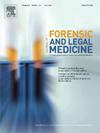Patterns and predictors of genital tract injuries among pre-pubertal and adolescent girls with child sexual abuse in Nigeria
IF 1.2
4区 医学
Q3 MEDICINE, LEGAL
引用次数: 0
Abstract
Background
Genital tract injuries are common following child sexual abuse. We aimed to describe the pattern of genital tract injuries and assess the predictors of genital tract injuries following child sexual abuse.
Method
ology: This was a cross-sectional study involving survivors of child sexual abuse in Ekiti State, Nigeria. The medical records of 386 children who received medical care on account of contact sexual abuse at Ekiti Sexual Assault Referral Centre, Ado- Ekiti, between June 2020 and August 2024 were reviewed and categorised according to Sommer's classification of genital injuries. Data were analysed with SPSS version 29. Binominal logistic regression was used to assess the predictors. A p-value of <0.05 was taken as statistically significant.
Results
Of the 386 participants, 184 (47.7 %) had genital tract injuries, 43 (11.1 %) had severe genital tract injuries, and 123 (31.9 %) had hymenal injuries. Genital tract injuries were mostly entry-point injuries. Predictors of genital tract injuries were prior sexual activity (OR 0.52, 95 % CI 0.30–0.91, p = 0.002), use of force (OR 3.2, 95 % CI 1.64–6.26, p < 0.001), use of inducement (OR 0.55, 95 % CI 0.29–0.89, p = 0.04), other body injuries (OR 4.78, 95 % CI 1.51–15.1, p = 0.008), and injury to the perpetrator (OR 2.79, 95 % CI 1.92–8.39, p = 0.04).
Conclusion
The prevalence of anogenital tract injuries is comparable between pre-pubertal and adolescent girls. Diverse factors may preclude genital tract injuries in child sexual abuse; the use of force during the act remains the pivotal predictor, while prior sexual activity halves the risk.
尼日利亚遭受儿童性虐待的青春期前和青春期女孩的生殖道损伤模式和预测因素
背景:儿童性侵后生殖道损伤很常见。我们的目的是描述模式的生殖道损伤和评估预测生殖道损伤后的儿童性虐待。方法:这是一项涉及尼日利亚埃基蒂州儿童性虐待幸存者的横断面研究。对2020年6月至2024年8月期间在Ado- Ekiti Ekiti性侵犯转诊中心因接触性侵犯而接受治疗的386名儿童的医疗记录进行了审查,并根据Sommer的生殖器损伤分类进行了分类。数据采用SPSS version 29进行分析。采用二项逻辑回归评估预测因子。p值为<;0.05为有统计学意义。结果386例患者中,生殖道损伤184例(47.7%),重度生殖道损伤43例(11.1%),处女膜损伤123例(31.9%)。生殖道损伤多为进入点损伤。生殖道损伤的预测因子为既往性行为(OR 0.52, 95% CI 0.30-0.91, p = 0.002)、使用暴力(OR 3.2, 95% CI 1.64-6.26, p <;0.001),使用诱导(OR 0.55, 95% CI 0.29-0.89, p = 0.04),其他身体伤害(OR 4.78, 95% CI 1.51-15.1, p = 0.008),以及对犯罪者的伤害(OR 2.79, 95% CI 1.92-8.39, p = 0.04)。结论青春期前少女与青春期少女的肛门生殖道损伤发生率相当。多种因素可能会排除儿童性虐待造成的生殖道损伤;在性行为中使用武力仍然是关键的预测因素,而之前的性行为将风险减半。
本文章由计算机程序翻译,如有差异,请以英文原文为准。
求助全文
约1分钟内获得全文
求助全文
来源期刊

Journal of forensic and legal medicine
MEDICINE, LEGAL-
CiteScore
2.70
自引率
6.70%
发文量
106
审稿时长
57 days
期刊介绍:
The Journal of Forensic and Legal Medicine publishes topical articles on aspects of forensic and legal medicine. Specifically the Journal supports research that explores the medical principles of care and forensic assessment of individuals, whether adult or child, in contact with the judicial system. It is a fully peer-review hybrid journal with a broad international perspective.
The Journal accepts submissions of original research, review articles, and pertinent case studies, editorials, and commentaries in relevant areas of Forensic and Legal Medicine, Context of Practice, and Education and Training.
The Journal adheres to strict publication ethical guidelines, and actively supports a culture of inclusive and representative publication.
 求助内容:
求助内容: 应助结果提醒方式:
应助结果提醒方式:


